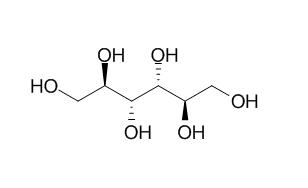Mannitol
Mannitol is a osmotic diuretic, it may play a role in reducing off-target 68Ga-PSMA renal uptake. Mannitol has been used clinically to reduce intracranial pressure with varying success, and it is possible that it is more effective in some types of head injury than in others.
Inquire / Order:
manager@chemfaces.com
Technical Inquiries:
service@chemfaces.com
Tel:
+86-27-84237783
Fax:
+86-27-84254680
Address:
1 Building, No. 83, CheCheng Rd., Wuhan Economic and Technological Development Zone, Wuhan, Hubei 430056, PRC
Providing storage is as stated on the product vial and the vial is kept tightly sealed, the product can be stored for up to
24 months(2-8C).
Wherever possible, you should prepare and use solutions on the same day. However, if you need to make up stock solutions in advance, we recommend that you store the solution as aliquots in tightly sealed vials at -20C. Generally, these will be useable for up to two weeks. Before use, and prior to opening the vial we recommend that you allow your product to equilibrate to room temperature for at least 1 hour.
Need more advice on solubility, usage and handling? Please email to: service@chemfaces.com
The packaging of the product may have turned upside down during transportation, resulting in the natural compounds adhering to the neck or cap of the vial. take the vial out of its packaging and gently shake to let the compounds fall to the bottom of the vial. for liquid products, centrifuge at 200-500 RPM to gather the liquid at the bottom of the vial. try to avoid loss or contamination during handling.
J Nat Prod.2022, 85(5):1351-1362.
Oncotarget.2016, 8(51):88386-88400
PLoS One.2022, 17(4):e0267007.
J Cell Physiol.2020, 10.1002
Chin Med.2022, 17(1):66.
Int J Mol Sci.2022, 23(1):538.
bioRxiv - Biochemistry2023, 541790.
J Chromatogr A.2022, 1685:463640.
Int J Biol Macromol.2020, 169:342-351
FEBS Lett.2021, 595(20):2608-2615.
Related and Featured Products
J Neurosurg. 1985 Jul;63(1):43-8.
Effect of mannitol on cerebral blood flow and cerebral perfusion pressure in human head injury[Pubmed:
3925092 ]
Patients with severe head injury frequently have evidence of elevated intracranial pressure (ICP) and ischemic neuronal damage at autopsy. Mannitol has been used clinically to reduce ICP with varying success, and it is possible that it is more effective in some types of head injury than in others.
METHODS AND RESULTS:
The aim of the present study was to determine the effect of Mannitol on ICP, cerebral perfusion pressure (CPP), and cerebral blood flow (CBF) in patients with severe head injury, and to discover if these effects differed in different types of injury. Measurements of CPP, ICP, and CBF were made in 55 patients with severe head injury. In general, the resting level of CBF was higher in patients with diffuse injury (mean 50.2 ml/100 gm/min) than in those with focal injury (mean 39.8 ml/100 gm/min). Mannitol consistently reduced ICP and increased CPP and CBF by 10 to 20 minutes after infusion. The lowest flows (31.8 ml/100 gm/min) were recorded from the most damaged hemispheres of patients with focal injuries and elevated ICP. The baseline levels of flow did not correlate with ICP, CPP, Glasgow Coma Scale score, or outcome. Only four of the 55 patients had a CBF of less than 20 ml/100 gm/min in either or both hemispheres.
CONCLUSIONS:
The few low CBF's in this and other studies may reflect the steady-state conditions under which measurements are made in intensive care units, and that these patients have entered a phase of reperfusion.
Eur J Nucl Med Mol Imaging. 2017 Aug 11.
Reduction of 68Ga-PSMA renal uptake with mannitol infusion: preliminary results.[Pubmed:
28801787]
Urea-based prostate-specific membrane antigen (PSMA) ligands labelled with 68Ga or 177Lu are new tracers with great potential for theranostic approaches in prostate cancer. However, clinical studies have shown that the kidneys are one of the off-target organs along with the salivary and lacrimal glands. In the kidneys, PSMA is physiologically expressed in the apical epithelium of the proximal tubules, and Mannitol acts as an osmotic diuretic in these tubules.
METHODS AND RESULTS:
We investigated the potential of Mannitol to reduce renal uptake of 68Ga-PSMA. Kidney uptake (SUVmax) was calculated in nine patients undergoing 68Ga-PSMA PET/CT at baseline (b-PET/CT) and after intravenous infusion of 500 ml of 10% Mannitol (m-PET/CT). Two different infusion schemes for Mannitol were used: (1) 500 ml Mannitol was infused over 40 min after 68Ga-PSMA administration (A-infusion) and (2) 250 ml Mannitol was infused over 15 min before and again after 68Ga-PSMA administration (B-infusion). In patients receiving the A-infusion, mean SUVmax increased by 11.9% and 7.4% in the right and left kidney, respectively. In patients receiving the B-infusion, mean SUVmax decreased by 24.3% and 22.4% in the right and left kidney, respectively. Our preliminary findings indicate that Mannitol may play a role in reducing off-target 68Ga-PSMA renal uptake. Administration of the osmotic diuretic should be rapid and start before 68Ga-PSMA injection.
CONCLUSIONS:
These results warrant dosimetric studies in patients treated with 177Lu-PSMA to find the best scheme for Mannitol administration.



